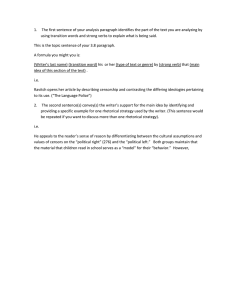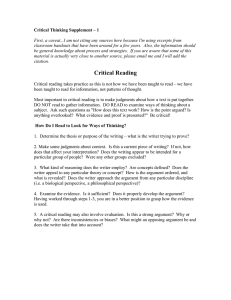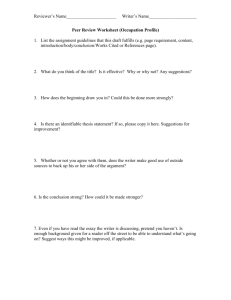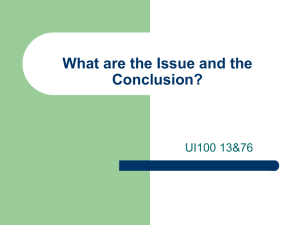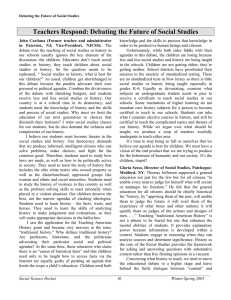Three Ways to Support an Argument
advertisement
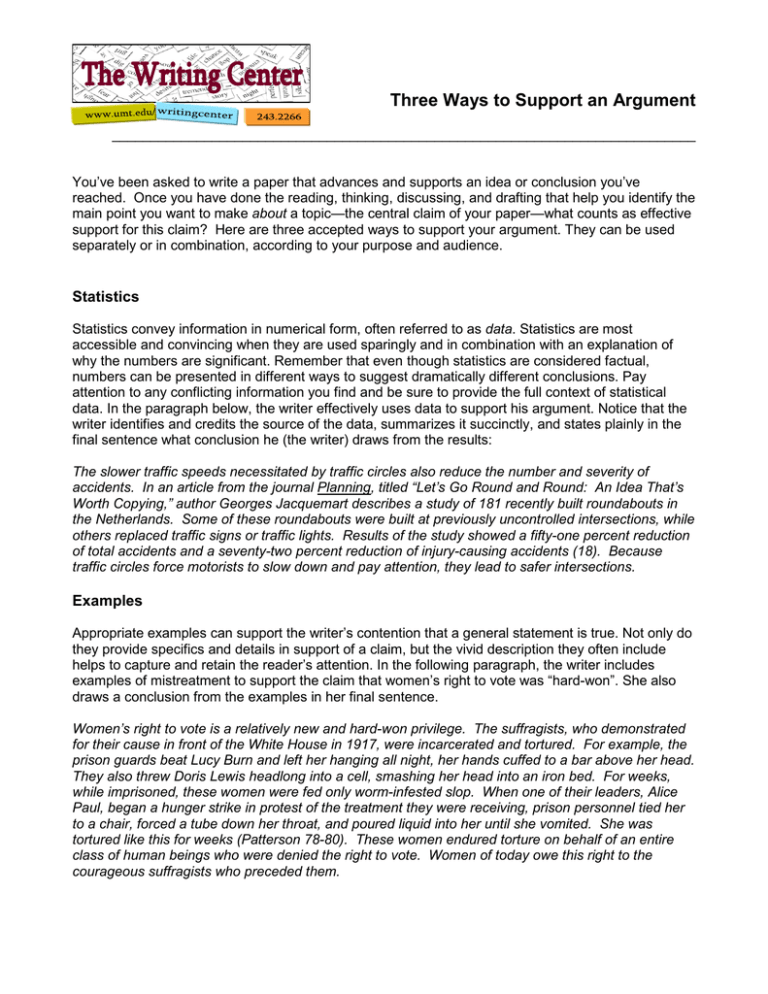
Three Ways to Support an Argument ____________________________________________________________________________ You’ve been asked to write a paper that advances and supports an idea or conclusion you’ve reached. Once you have done the reading, thinking, discussing, and drafting that help you identify the main point you want to make about a topic—the central claim of your paper—what counts as effective support for this claim? Here are three accepted ways to support your argument. They can be used separately or in combination, according to your purpose and audience. Statistics Statistics convey information in numerical form, often referred to as data. Statistics are most accessible and convincing when they are used sparingly and in combination with an explanation of why the numbers are significant. Remember that even though statistics are considered factual, numbers can be presented in different ways to suggest dramatically different conclusions. Pay attention to any conflicting information you find and be sure to provide the full context of statistical data. In the paragraph below, the writer effectively uses data to support his argument. Notice that the writer identifies and credits the source of the data, summarizes it succinctly, and states plainly in the final sentence what conclusion he (the writer) draws from the results: The slower traffic speeds necessitated by traffic circles also reduce the number and severity of accidents. In an article from the journal Planning, titled “Let’s Go Round and Round: An Idea That’s Worth Copying,” author Georges Jacquemart describes a study of 181 recently built roundabouts in the Netherlands. Some of these roundabouts were built at previously uncontrolled intersections, while others replaced traffic signs or traffic lights. Results of the study showed a fifty-one percent reduction of total accidents and a seventy-two percent reduction of injury-causing accidents (18). Because traffic circles force motorists to slow down and pay attention, they lead to safer intersections. Examples Appropriate examples can support the writer’s contention that a general statement is true. Not only do they provide specifics and details in support of a claim, but the vivid description they often include helps to capture and retain the reader’s attention. In the following paragraph, the writer includes examples of mistreatment to support the claim that women’s right to vote was “hard-won”. She also draws a conclusion from the examples in her final sentence. Women’s right to vote is a relatively new and hard-won privilege. The suffragists, who demonstrated for their cause in front of the White House in 1917, were incarcerated and tortured. For example, the prison guards beat Lucy Burn and left her hanging all night, her hands cuffed to a bar above her head. They also threw Doris Lewis headlong into a cell, smashing her head into an iron bed. For weeks, while imprisoned, these women were fed only worm-infested slop. When one of their leaders, Alice Paul, began a hunger strike in protest of the treatment they were receiving, prison personnel tied her to a chair, forced a tube down her throat, and poured liquid into her until she vomited. She was tortured like this for weeks (Patterson 78-80). These women endured torture on behalf of an entire class of human beings who were denied the right to vote. Women of today owe this right to the courageous suffragists who preceded them. Examples (cont.) Below, the writer uses a personal example to support his agreement with the author of a text. Notice how the writer both tells his story with details and ends the paragraph by spelling out why the story is relevant to his argument: I agree with Djilas that anticipating torture can often be more terrifying than actual torture. When I needed to go to the doctor to get a shot, I put off scheduling the appointment as long as possible. I am terrified by the mere idea of being stuck with a needle. I didn’t sleep well the night before my appointment, and by the time I arrived at the doctor’s office, I was jittery and pale. As the doctor prepared to give me the shot, I squeezed my eyes shut to block out the horrible pain I was sure was coming. Then I felt the tiniest little pinch. That was all. It was over. Although state-sponsored torture is certainly far worse than a simple shot in the arm, my experience has led me to believe that the combination of anticipation and fear one experiences prior to a painful situation often causes more discomfort than the situation itself. Expert Opinion Expert opinions are based on factual evidence but differ from fact in that they are interpretations of fact. For example, psychiatrists determining a criminal’s mental state may consider the same data set and observation yet offer differing interpretations of this information. The fate of the criminal—mental hospital versus prison—may depend upon which argument is more convincing. The fact that experts can draw different conclusions from the same information shows that opinions may not be as reliable as facts or personal experience, but they are a useful and common means of supporting an argument. In much of the argumentative writing you do, you will rely upon the opinions of experts in the field you are studying both to determine your own perspective and to support your claims. The following passage is taken from an essay titled “The Decline and Fall of Teaching History,” in which author Diane Ravitch argues that an ignorance of history will prevent people from being able to make independent judgments on current issues. Ravitch cites the opinion of a university professor as support for her claim: My gloomy assessment was echoed by Naomi Miller, chairman of the history department at Hunter College in New York. “My students have no historical knowledge on which to draw when they enter college,” she said.…Professor Miller believes that “we are in danger of bringing up a generation without historical memory. This is a dangerous situation.” In citing Miller, Ravitch is using the experience, credentials, and conclusions of someone else to vouch for her argument. Miller’s words, if you will, are used to bear witness to the situation Ravitch is describing. Miller’s profession and high rank strongly imply that Miller has the necessary experience with entering college students to draw sound conclusions. Citing an expert for any argument is easy to do and its success depends on your choosing an expert with the relevant credentials. How effective would Ravitch be had she quoted a famous talk show host? A Note on Visuals: Support also can be integrated into a paper as charts, figures, tables, illustrations, etc. Translating important information into a visual can both aid in readability and provide visual impact. However, the purpose of these visuals usually should be to report data too numerous or complicated to be described adequately in the text and/or to reveal trends or patterns in the data. Since visuals should compliment your writing by adding necessary information, you must determine how information can be best conveyed to your readers—in words, numbers, tables, or figures. Decide how to best present information based on your purpose and the needs of the reader.
